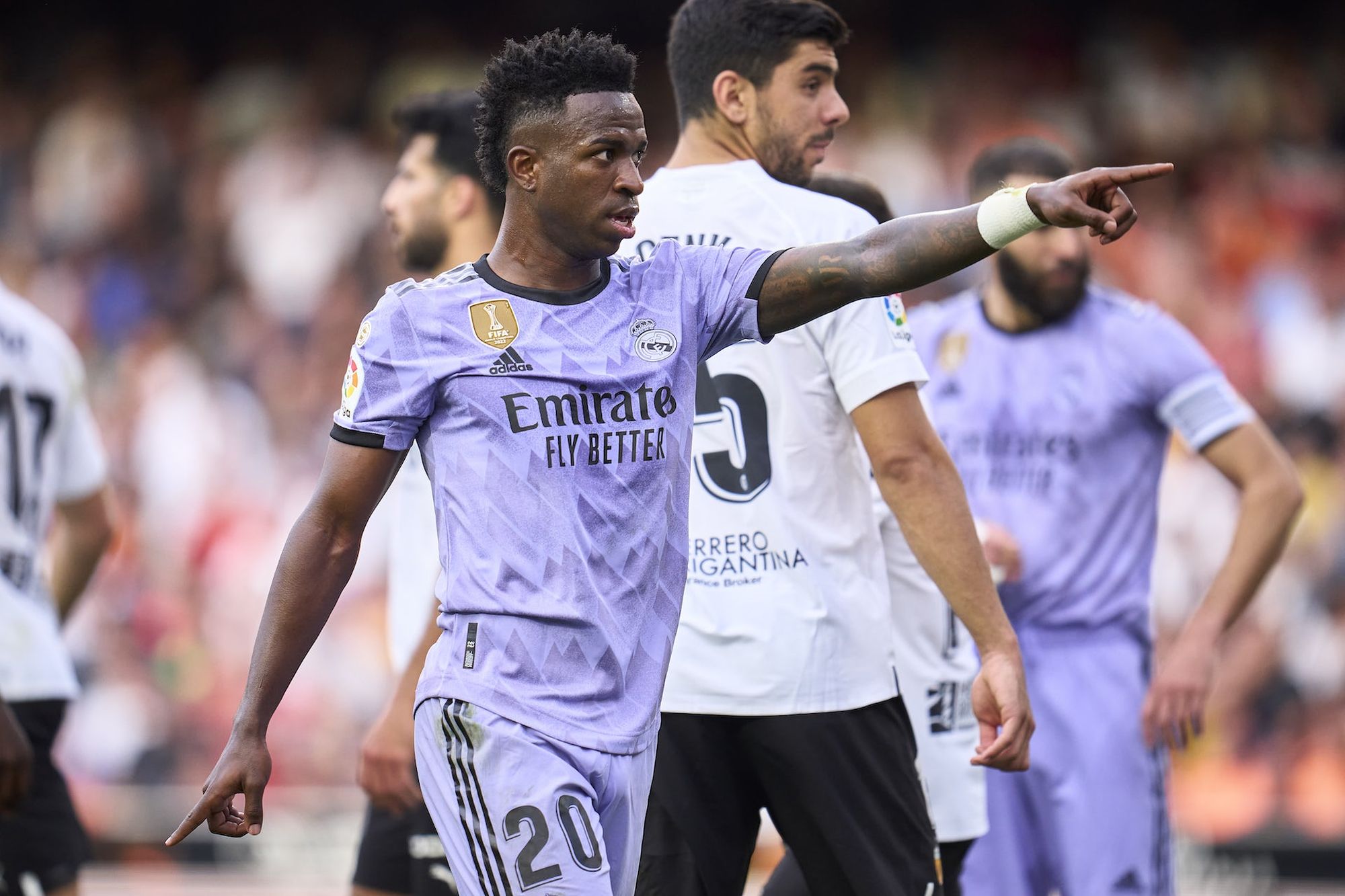After suffering months of racial abuse on the field and off, Brazilian soccer star Vinícius Júnior had enough.
On May 21, 2023, the Real Madrid forward – commonly seen as one of the best soccer players in the world – brought a halt to a game at Valencia’s Mestalla Stadium, pointing to fans who were making blatantly racist remarks and gestures.
He later made it clear that this was not an isolated event: “It was not the first time, nor the second, nor the third. Racism is normal in La Liga,” he tweeted in reference to the Spanish top division. “The competition considers it normal, the federation considers it normal and the rivals encourage it.”
As a soccer scholar whose latest book includes analysis of how players, fans and the game’s governing bodies have responded to the Black Lives Matter movement, I believe the latest incident points to how difficult it is to change fan behavior when racism remains institutionalized in the sport itself.
While it is true that teams and leagues have made progress in signaling their lack of tolerance for racist behavior, there remain systemic problems working against real progress – not least the lack of Black representation in management positions.
Deep roots of soccer racism
Soccer has a long-established racism problem. Black players throughout the decades attest to both abuse by fans – monkey chants are still common during games in parts of Europe – as well as more subtle forms of discrimination, such as being left out of national squads or overlooked for coaching positions.
Black Brazilians such as Vinícius and stretching back to Pelé have been subjected to racism both overseas and at home. Indeed, as soccer writer Franklin Foer has pointed out, in the early days of Brazilian soccer Black people were not allowed to play for professional clubs or the national team.
Even when finally accepted, some of the star Black players like Arthur Freidenreich and Joaquim Prado would straighten their hair and attempt to lighten their skin in the hope of gaining popularity.
While there has been great change since such times, the roots of subtle and overt racism facing Black soccer players run deep – be it in their home countries or playing for prestigious European clubs.
Soccer’s Black Lives Matter moment
While one can argue that there have always been minor attempts to address racism in soccer, it has only really been in the last decade that such efforts have gained steam. And it has been geared very much toward changing attitudes among fans.
For example, in England, the Football Association has long partnered with anti-racist group Kick It Out to create programs and punishments for racist fan behavior. Meanwhile, the Royal Spanish Football Association has codes for applying financial penalties against clubs with racist fans.
Such anti-racist efforts and messaging increased as part of a more general societal reckoning over racism after the killing in the U.S. of George Floyd by a police officer in 2020.
Soccer authorities – usually wary of political statements and quick to punish players who display protest slogans on shirts – by and large allowed players free expression in regard to Floyd’s killing and the protests it sparked.
Indeed, after restarting a pandemic-struck season in June 2020, the English Premier League promoted an active Black Lives Matter campaign. This included “Black Lives Matter” patches on uniforms – although patches were later amended to read “No Room for Racism” – and allowing the taking of the knee before games. Three years on, many players and teams still take a knee before games throughout England.
But it hasn’t stopped the abuse. In 2020, while players on the pitch were presenting a unified front against anti-Black racism, British Home Office Minister Susan Williams observed that racist incidents had risen for the third year in a row.
Soccer leagues in southern Europe tended to leave it to clubs and individuals to respond to the Black Lives Matter movement, rather than having any blanket policies akin to that of the English Football Association.
But again, it appears to have had little effect on crowd racism.
Italian soccer continues to garner a reputation for racism among its fan base. While examples are numerous, the most recent cases include verbal attacks against Lecce defender Samuel Umtiti and forward Lameck Banda while playing at Lazio, and racists taunts against Inter Milan striker Romelu Lukaku after he scored against Juventus in a Copa Italia semifinal.
In Spain, after the latest Vinícius incident, football federation chief Luis Rubiales acknowledged that racism was a problem in the league. It would be hard not to: The abuse of May 21 was at least the 10th racist incident against the Brazilian star that Real Madrid has reported to the league this season.
The diplomatic fallout of the Vinícius abuse – Brazil summoned the Spanish ambassador, and Rio’s Christ the Redeemer statue was shrouded in darkness in protest – has reignited discussion of what action needs to be taken to stamp out racism in the game.
Spanish police have made several arrests over Vinícius’ abuse. Meanwhile, La Liga has fined Valencia – the team Real Madrid was playing – 45,000 euros (US$ 48,000) and closed a portion of the stadium for the next five games.
But given how persistent crowd racism has been in the face of numerous attempts to challenge it, I believe it is fair to ask if such disciplinary actions will have any real impact now.
Counter-cosmopolitanism
Continued racism in European soccer comes despite a rise in soccer’s “cosmopolitanism” culture. Prior to the 1990s, Black players in the top European leagues were relatively few and far between – especially in countries where nonwhite players would fear being subjected to racist taunts from their own supporters, as well as the opposition’s.
But modern-day fans have long become accustomed to supporting a racially diverse team. So why does racism in stadiums persist? Political scientist and sociologists Andrei Markovits and Lars Rensmann point out in “Gaming the World” that the rise in cosmopolitanism on the field is not reflected in the stands – that is, in European leagues, the makeup of fan bases is not as diverse as that of the team they go to cheer on.
Markovits and Rensmann argue that what we are witnessing in the stands is a kind of “counter-cosmopolitanism” in which the “other” is treated with anger and suspicion because they are deemed to threaten the stable sense of identity of some fans.
If the racial makeup of teams is not reflective of the fan base, it also isn’t reflected in management, or among the people who govern the sport.
Analysis conducted in May 2022 found that of the 98 clubs that played in the five most prestigious European leagues – the English Premier League, La Liga, and Italy’s Seria A, along with Germany’s Bundesliga and France’s Ligue 1 – only two had Black managers. La Liga had none, and still doesn’t.
Failing the Sterling standard
As England striker Raheem Sterling noted in a 2020 interview: “There’s something like 500 players in the Premier League and a third of them are Black, and we have no representation of us in the hierarchy, no representation of us in the coaching staffs.”
While there is certainly some merit in the actions being taken in Spain to address behavior in the stands in the aftermath of the latest Vinícius incident, there is an argument that it is too little, too late. Moreover, it does little to address more institutionalized racism in the game. And to date, anti-racism programs and fines have failed to stamp out racism in soccer.
As Sterling noted, “When there’s more Black people in positions, when I can have someone from a Black background … (to) be able to go to in the [Football Association] with a problem I have within the club – these will be the times that I know that change is happening.”
John M Sloop is a professor of Communication Studies at Vanderbilt University.
This article was originally published in The Conversation. Read the original article here: https://theconversation.com/european-soccer-is-having-another-reckoning-over-racism-is-it-time-to-accept-the-problem-goes-beyond-bad-fans-206391














